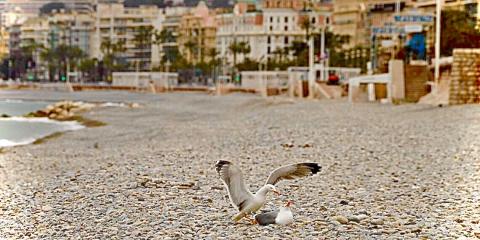A speedy Covid-19 vaccination marketing campaign within the U.S. holds the promise that thousands and thousands of People can return to seaside holidays, barbecues and street journeys this summer season.
In contrast, Europeans are dealing with what may very well be a summer season of discontent.
European Union governments had hoped that sufficient Europeans can be vaccinated within the early a part of 2021 to loosen restrictions and permit for a comparatively regular summer season. For thousands and thousands of companies which have held on all winter—particularly in Italy, Greece and Spain, the place tourism makes up a big chunk of jobs and financial exercise—that might have been an immense aid.
As an alternative, the sluggish tempo of the EU’s vaccination marketing campaign, compounded by recent concerns over the safety of
AstraZeneca
PLC’s shot, means Europe’s economic system will lag far behind the U.S. Some tourism-dependant international locations comparable to Spain might even contract once more this 12 months.
Quite a few EU international locations—together with France and Italy—have reinstated strict restrictions and partial lockdowns as they proceed to fight excessive ranges of coronavirus infections. In response to Google Mobility information, visits to retail and recreation areas like eating places, cafes and procuring facilities in Western Europe are half the extent of pre-pandemic visitors. Within the U.S., visits are about 10% beneath the extent when coronavirus hit.
These restrictions imply the eurozone economic system was already anticipated to contract throughout the first three months of 2021, coming into a double-dip recession, whereas the U.S. economic system is anticipated to develop 1.5% over the identical interval.
Now, the sluggish vaccination marketing campaign suggests the eurozone’s economy will stay mired for months. Large EU international locations comparable to France, Germany and Italy have administered no less than one vaccination shot to lower than 10% of their inhabitants, in contrast with 23% within the U.S.

Santorini island was quiet in June 2020 as Greece ready for a return of vacationers that finally contributed to a second Covid-19 surge in Europe.
The EU set a goal for member international locations to have 70% of their populations vaccinated by September, a purpose most have stated they’d meet or exceed. However that tempo stays unsure given provide issues and the refusal of many Europeans to get the AstraZeneca shot.
Now, Giorgio Ravecca, who runs a seaside resort on Italy’s northwest coast, worries the Italian authorities will curtail seaside tourism this 12 months. The nation has stored its ski slopes shut for the whole winter season, one thing Mr. Ravecca fears might occur to his sector.
“The authorities have misplaced a lot time with the vaccine rollout that it’s going to return too late to assist us this summer season,” stated Mr. Ravecca.
Tourism and journey contribute round 13% of Italy’s GDP, in response to the World Journey and Tourism Council. That share rises to 14% for Spain and 21% in Greece. The share within the U.S. and most of Europe’s north is beneath 10%.
Whole revenues from tourism and journey final 12 months dropped by half in Italy to €88 billion—or $105 billion—and by practically two-thirds in Spain to €44 billion, in response to analysis agency Oxford Economics.
It’s unclear what restrictions governments plan to maintain in place for the summer season. Permitting vacationers to journey with few restrictions final summer season planted the seeds for Europe’s second wave of the pandemic.
Whereas Greece and Portugal have indicated they are going to start opening up in Might to overseas vacationers, a brand new uptick in infections might result in delays.
Earlier than the bumpy begin to the EU’s vaccination applications, coverage makers had anticipated a modest restoration within the three months by means of June that might speed up sharply throughout the summer season on the again of an acceleration in inoculations. Underneath that situation, slightly below half of the eurozone’s 19 members would return to pre-pandemic ranges of output by the tip of this 12 months, whereas the eurozone’s economic system would broaden by about 4% in 2021, in contrast with 6.5% progress anticipated within the U.S. this 12 months.
A lack of the summer season trip enterprise would hit onerous.
If the reopening is delayed by three months or longer, the EU expects the eurozone to develop by simply 2.5% this 12 months. As an alternative of reaching pre-pandemic ranges of output by early subsequent 12 months, the eurozone economic system wouldn’t get better by the tip of 2022. Furthermore, a slower restoration might depart longer-term harm to the eurozone economic system.
Even when restrictions are lifted by this summer season, the EU expects neither Italy nor Spain to have returned to pre-pandemic ranges of output by the tip of 2022, already a 12 months later than Germany, exacerbating a longstanding divide between Europe’s affluent north and its lagging south.
Certainly, economists at Morgan Stanley estimate that Spain’s economic system might shrink once more in 2021 if the tourism season is weaker than final 12 months.
Whereas providers have been onerous hit, some European producers have adjusted to the restrictions, avoiding the closures they suffered in 2020 and having fun with a robust rebound this 12 months.
Industrial manufacturing within the eurozone rose barely in January from the identical interval a 12 months earlier, ending two years of contraction. In April, Italy’s manufacturing sector expanded for an eighth straight month.
Barbara Colombo, chief government, an Italian firm that makes machine instruments for the metal business, struggles to search out individuals to fill open jobs in her factories. She didn’t make use of Italy’s Covid furlough program that allowed corporations to furlough staff with the whole price picked up by the federal government. Her order guide is a few quarter beneath the place it was proper earlier than the pandemic hit Italy, however she’s anticipating the state of affairs to enhance this 12 months.
“There’s cautious optimism within the (machine instruments) sector,” stated Ms. Colombo, who has 600 workers. “Orders are arriving and that’s giving corporations the braveness to start out investing once more.”
Nevertheless, sturdy manufacturing is unlikely to completely offset weak spot within the area’s giant providers sector stemming from renewed lockdowns.
On the similar time, European banks have been making it more durable and dearer for companies and households to borrow, nervous that the intensifying pandemic would harm their capacity to repay the debt, in response to European Central Financial institution information. Financial institution lending to eurozone corporations floor to a halt between December and January.
The European Central Financial institution stated final week it could step up its purchases of eurozone debt to comprise borrowing prices which have surged amid brighter prospects for the U.S. economic system and a relaxed stance from the Federal Reserve.
